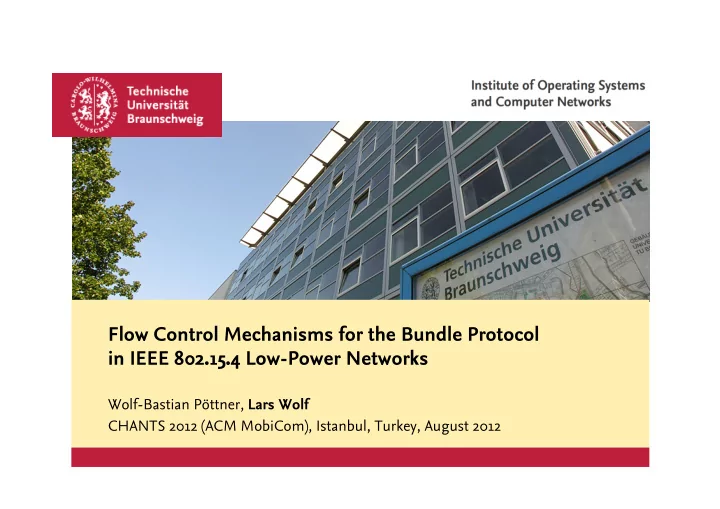

Platzhalter für Bild, Bild auf Titelfolie hinter das Logo einsetzen Flow Control Mechanisms for the Bundle Protocol in IEEE 802.15.4 Low-Power Networks Wolf-Bastian Pöttner, Lars Wolf CHANTS 2012 (ACM MobiCom), Istanbul, Turkey, August 2012
Motivation Wireless Sensor Networks (WSNs) • Battery-powered nodes, limited hardware capabilities • Wireless communication, usually IEEE 802.15.4 • Unstable links, changing topologies • Many publications use DTN, but not Bundle Protocol Delay Tolerant Wireless Sensor Networks (DT-WSNs) • Sensor Networks using store, carry and forward protocol • Bundle Protocol allows seamless backend integration Lars Wolf | Flow Control for DT-WSN | Page 2 / 9
Bundle Protocol in IEEE 802.15.4 Wireless Networks Bundle Protocol over IEEE 802.15.4 Wireless Links • Bundle Protocol designed as overlay protocol on Layer 5 • But: Significant overhead IEEE 802.15.4 Convergence Layer • Transports bundles inside IEEE 802.15.4 MAC frames • Avoids network and transport layer, has to handle their tasks • IEEE 802.15.4 MAC does CRC, ACKs, retransmissions,... • Flow Control necessary to avoid overrunning receivers • WSN nodes are slow due to limited resources Lars Wolf | Flow Control for DT-WSN | Page 3 / 9
Problem Statement Assumptions • Persistent bundle storage in flash (not enough RAM) • Writing a page (0.5 - 5ms) slower than reading (<<1ms) • File systems and OS make the delay variable over time Problem Statement • Ensure inter-packet-delay t D is large enough to give sender and receiver time. TX" RX" TX" RX" • Or: t D ≥ max( T R , T S ) t S,2 t S,1 Sender" Data" Data" t" ACK" ACK" Goal • Minimize t D t R,2 t R,1 Receiver" RX" TX" RX" TX" t" t D Lars Wolf | Flow Control for DT-WSN | Page 4 / 9
Four Di ff erent Flow Control Mechanisms (1/2) • Fixed Delay between outgoing packets TX" RX" TX" RX" t S,1 t S,2 Sender" Data" Data" t" ACK" ACK" t R,1 t R,2 Receiver" RX" TX" RX" TX" t" Fixed"Delay" • TCP-inspired approximation of processing time TX" RX" TX" RX" "" t S,1 t S,2 Sender" "" "" Data" Data" t" Delay&t D& ACK" ACK" "" "" Threshold" t R,1 t R,2 Receiver" "" RX" TX" RX" TX" t" "" Variable"Delay" Transmissions& Lars Wolf | Flow Control for DT-WSN | Page 5 / 9
Four Di ff erent Flow Control Mechanisms (2/2) • Application-Layer ACKs when processing is done TX" RX" RX" TX" RX" t S,1 t S,2 Sender" App=Layer"ACK" Data" Data" t" ACK" ACK" t R,1 t R,2 Receiver" RX" TX" TX" RX" TX" t" Applica:on"Layer"ACK" • Receiver-feedback on estimated processing time TX" RX" TX" RX" t S,1 t S,2 Sender" Data" Data" t" ACK" ACK" t R,1 t R,2 Receiver" RX" TX" RX" TX" t" Receiver"Feedback" Lars Wolf | Flow Control for DT-WSN | Page 6 / 9
Application-layer Throughput [bytes/s] Application-layer Throughput [bytes/s] Application-layer Throughput [bytes/s] Application-layer Throughput [bytes/s] Evaluation: Application Layer Throughput 600 600 600 600 500 500 500 500 400 400 400 400 300 300 300 300 200 200 200 200 100 100 100 100 0 0 0 0 0 0 0 0 10 10 10 10 20 20 20 20 30 30 30 30 40 40 40 40 50 50 50 50 60 60 60 60 70 70 70 70 80 80 80 80 Payload Length [bytes] Payload Length [bytes] Payload Length [bytes] Payload Length [bytes] Fixed-Delay Fixed-Delay Fixed-Delay App-Layer ACKs App-Layer ACKs App-Layer ACKs Fixed-Delay App-Layer ACKs TCP-inspired TCP-inspired Receiver-feedback Receiver-feedback TCP-inspired TCP-inspired Receiver-feedback Receiver-feedback • App-layer ACK & Receiver-feedback show highest throughput Lars Wolf | Flow Control for DT-WSN | Page 7 / 9
Evaluation: TX Energy Consumption (via transmitted data) 60000 Total Transmitted Data [bytes] 45000 30000 15000 0 0 10 20 30 40 50 60 70 80 Payload Length [bytes] Fixed-Delay App-Layer ACKs TCP-inspired Receiver-feedback § App-Layer ACK shows highest energy consumption because additional ACK packets have to be transmitted Lars Wolf | Flow Control for DT-WSN | Page 8 / 9
Lars Wolf Wolf-Bastian Pöttner wolf@ibr.cs.tu-bs.de poettner@ibr.cs.tu-bs.de Conclusions http://www.ibr.cs.tu-bs.de/projects/mudtn/ • Delay Tolerant Wireless Sensor Networks (DT-WSN) • Low-Power nodes built around µC running on batteries • IEEE 802.15.4 as predominant wireless communication • IEEE 802.15.4 Convergence Layer • Operates directly on top of MAC layer to reduce overhead • Takes care of typical L3+L4 duties. Here: Flow Control • Flow Control for IEEE 802.15.4 CL • App-Layer ACK: high throughput and energy consumption • Receiver-feedback: Energy e ffi cient but platform specific • µDTN is available as open-source software Lars Wolf | Flow Control for DT-WSN | Page 9 / 9
Recommend
More recommend